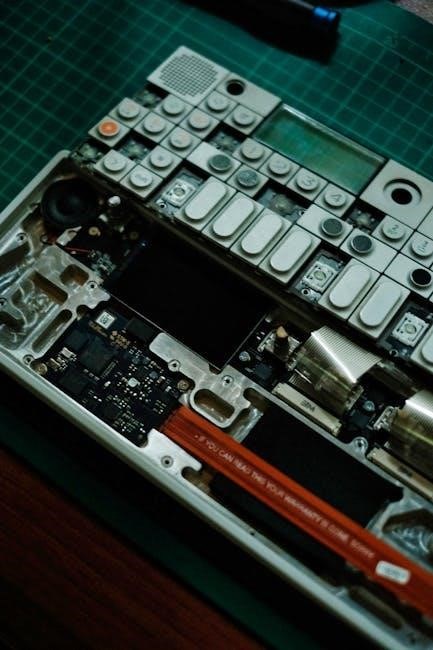
basic electronics pdf
An electrical circuit is a path through which electrons flow, powered by a voltage or current source. It consists of components like resistors, capacitors, and inductors, enabling various applications in electronics.
1.1 Electrical Quantities and Units
In basic electronics, understanding fundamental electrical quantities and their units is crucial. Key quantities include voltage (measured in volts), current (amperes), resistance (ohms), power (watts), and energy (joules). Voltage represents the potential difference driving electrons, while current is the flow rate of electrons. Resistance, measured in ohms, opposes current flow. Power, in watts, indicates energy transfer per unit time, and energy, in joules, represents total work done. These units form the basis for analyzing and designing electrical circuits. Grasping these concepts is essential for understanding how electrical systems function and interact.
- Voltage (V) = Volts (V)
- Current (I) = Amperes (A)
- Resistance (R) = Ohms (Ω)
- Power (P) = Watts (W)
- Energy (E) = Joules (J)
These foundational concepts are vital for advancing in electronics studies and practical applications.
1.2 Types of Electrical Circuits
Electrical circuits are classified into two primary types: DC (Direct Current) and AC (Alternating Current) circuits. DC circuits have current flowing in one direction, ideal for simple applications like batteries and electronic devices. AC circuits, however, have current that periodically reverses direction, commonly used in household power distribution. Additionally, circuits can be categorized as series or parallel, based on component connections. In series circuits, components are connected end-to-end, sharing the same current, while parallel circuits allow multiple paths for current flow, each with the same voltage. Understanding these circuit types is fundamental for designing and analyzing electronic systems. Mastering these basics enhances problem-solving skills in electronics and circuit design. These classifications guide engineers in selecting appropriate configurations for various applications.
- DC Circuits: Unidirectional current flow
- AC Circuits: Oscillating current reversal
- Series Circuits: Single path for current
- Parallel Circuits: Multiple current paths
1.3 Importance of Understanding Electrical Circuits
Understanding electrical circuits is fundamental for designing, analyzing, and troubleshooting electronic systems. It provides a foundation for grasping how components interact and function within a system. This knowledge enables the identification of faults, optimization of performance, and ensures safety in electrical installations. By mastering circuit principles, individuals can develop practical skills for building and repairing electronic devices. It also serves as a stepping stone for advanced topics like semiconductor devices and digital electronics. The ability to interpret circuit diagrams and apply theoretical concepts to real-world problems is invaluable in various fields, from engineering to hobbyist projects. Without this understanding, advancing in electronics or related disciplines becomes challenging. Thus, electrical circuits form the backbone of modern technology, making their study essential for anyone pursuing a career or interest in electronics.
- Foundational for advanced electronics topics
- Essential for troubleshooting and repair
- Crucial for designing efficient systems
- Enhances problem-solving and analytical skills

Electronic Components
Electronic components are the building blocks of electronic circuits, including resistors, capacitors, inductors, diodes, transistors, and integrated circuits. They control and regulate electrical signals in various applications.
2.1 Passive Components
Passive components are non-power-consuming elements that do not require an external energy source to function. They include resistors, capacitors, inductors, and transformers. Resistors oppose the flow of current, while capacitors store electrical energy in an electric field. Inductors store energy in a magnetic field when current flows through them. Transformers transfer electrical energy between circuits through electromagnetic induction. These components are fundamental in circuit design, ensuring proper voltage, current, and impedance levels. They are essential for filtering, timing, and energy storage applications in electronic circuits. Understanding their characteristics and uses is crucial for designing and analyzing electrical and electronic systems effectively.
2.2 Active Components
Active components are electronic elements that require an external power source to operate and are capable of amplifying or processing electrical signals. Examples include transistors, diodes, and integrated circuits (ICs). Diodes allow current to flow in one direction while blocking it in the other, making them useful for rectification. Transistors, such as Bipolar Junction Transistors (BJTs) and MOSFETs, act as switches or amplifiers, controlling current flow. Integrated circuits combine multiple components on a single chip, enabling complex functions like logic operations and signal processing. Active components are essential for creating dynamic and functional electronic systems, including amplifiers, oscillators, and digital circuits. They are fundamental to modern electronics, enabling innovations in communication, computing, and control systems.

Semiconductors
Semiconductors are materials with conductivity between conductors and insulators, essential in modern electronics. Silicon is the most common semiconductor, enabling the creation of diodes, transistors, and integrated circuits.
3.1 Types of Semiconductor Materials
Semiconductor materials are categorized into intrinsic and extrinsic types. Intrinsic semiconductors, like pure silicon or germanium, have no significant dopant species present. Extrinsic semiconductors are doped with impurities to enhance conductivity, classified as N-type (doped with phosphorus or arsenic) or P-type (doped with boron or aluminum). Silicon is the most widely used semiconductor due to its abundance and thermal stability. Germanium, though less common, is also utilized in specific applications. Gallium arsenide is another semiconductor material known for its high electron mobility and optical properties, often used in high-frequency devices and LEDs. Understanding these materials is crucial for designing diodes, transistors, and integrated circuits in modern electronics.
3.2 Semiconductor Diodes
A semiconductor diode is a two-terminal electronic component that allows current to flow in one direction while blocking it in the opposite direction. It consists of a p-n junction, where p-type material (positive charge carriers) and n-type material (negative charge carriers) meet. When forward-biased, the diode conducts electricity; when reverse-biased, it acts as an open circuit. Diodes are essential for rectification, voltage regulation, and signal demodulation. Common types include the Zener diode, used for voltage regulation, and the Schottky diode, known for its fast switching speeds. LEDs (Light Emitting Diodes) are another type, emitting light when forward-biased. Understanding diodes is fundamental for designing rectifiers, power supplies, and signal processing circuits in modern electronics.
3.3 Bipolar Junction Transistors (BJTs)
A Bipolar Junction Transistor (BJT) is a three-layer semiconductor device with two p-n junctions. It consists of an emitter, base, and collector. BJTs are classified into NPN and PNP types based on their layer structure. In NPN transistors, the current flows from collector to emitter, while in PNP, it flows from emitter to collector. BJTs operate in three modes: forward-active (amplification), saturation (fully on), and cutoff (fully off). They are commonly used as amplifiers or switches due to their ability to control large currents with small input signals. The current amplification factor (beta) determines their gain. BJTs are essential in circuits for signal amplification, switching, and power management. Understanding their characteristics, such as DC analysis and biasing, is crucial for designing efficient electronic circuits. Their versatility makes them a fundamental component in modern electronics, from audio amplifiers to digital logic circuits.

Digital Electronics Basics
Digital electronics involves circuits that process binary signals (0s and 1s). Fundamental concepts include logic gates, Boolean algebra, and binary number systems, enabling modern computing and communication systems.
4.1 Logic Gates
Logic gates are the building blocks of digital electronics, performing operations on binary signals (0s and 1s). They are used to implement logical functions such as AND, OR, NOT, NAND, NOR, XOR, and XNOR. These gates are fundamental in creating digital circuits and systems. Each gate processes input signals to produce a specific output based on its logical operation. For example, an AND gate outputs 1 only if both inputs are 1, while an OR gate outputs 1 if at least one input is 1. Logic gates are implemented using transistors and diodes, forming the basis of all digital integrated circuits. They are essential in computing, control systems, and communication technologies, enabling the creation of complex digital systems. Understanding logic gates is crucial for designing and analyzing digital electronic circuits and systems.
4.2 Boolean Algebra
Boolean algebra is a mathematical system used to analyze and simplify logical expressions in digital electronics. It operates on binary values (0 and 1) and employs logical operators such as AND, OR, and NOT. The system is based on axioms and theorems, including De Morgan’s Laws and the Distributive Law, which enable the simplification of complex logical expressions. Boolean algebra is essential for designing and optimizing digital circuits, as it allows engineers to minimize the number of logic gates required. This reduces circuit complexity, power consumption, and cost. It is also widely used in programming and computer science to implement logical operations and control flow. By mastering Boolean algebra, one can create efficient digital systems and solve real-world problems in electronics and computing effectively.

Essential Tools and Instruments
Essential tools in electronics include multimeters, oscilloscopes, soldering irons, and wire strippers. These instruments are crucial for designing, measuring, and troubleshooting electrical circuits, ensuring accuracy and safety in projects.
5.1 Multimeter
A multimeter is a versatile tool used to measure electrical quantities such as voltage, current, resistance, and continuity. It is essential for diagnosing and troubleshooting circuits. Available in analog or digital forms, multimeters provide precise readings, ensuring accuracy in measurements. Key functions include DC/AC voltage measurement, current measurement, resistance testing, and continuity checking. Proper use involves selecting the correct range and connecting test leads to the circuit. Safety precautions, like avoiding direct short circuits, are crucial; Multimeters are indispensable for engineers and hobbyists alike, aiding in the design, repair, and optimization of electronic systems. Regular calibration ensures reliability, making it a fundamental tool in every electronics workspace.
5.2 Oscilloscope
An oscilloscope is a critical tool for visualizing and measuring electrical signals in real-time. It displays waveforms, allowing users to analyze signal properties like amplitude, frequency, and phase. Available in analog and digital forms, oscilloscopes are essential for debugging and understanding complex circuits. Key features include adjustable sensitivity, timebase settings, and trigger controls for precise waveform capture. Modern oscilloscopes often include advanced functions like storage capability and waveform analysis. Proper use involves connecting probes correctly and setting appropriate scales. This instrument is indispensable for engineers and technicians, enabling them to observe transient phenomena and verify signal integrity. Regular calibration ensures accuracy, making it a cornerstone in electronics troubleshooting and design verification. Its ability to provide detailed insights into signal behavior makes it irreplaceable in both educational and professional electronics environments.

Circuit Design and Construction
Circuit design involves planning and simulating electronic circuits, while construction focuses on building them using breadboards and soldering. Proper testing and troubleshooting ensure functionality and reliability in the final design.
6.1 Creating Circuit Diagrams
Creating circuit diagrams is a fundamental step in electronics, enabling clear communication of design intent. These diagrams use standardized symbols for components like resistors, capacitors, and transistors. Schematic capture tools like SPICE or Proteus simplify the process, allowing simulation before physical construction. Accurate labeling and organization ensure readability, while color-coding or annotations can highlight critical paths or power sources. Properly designed diagrams aid in troubleshooting and documentation, making them essential for both prototyping and final production. Following industry standards ensures consistency and compatibility, while iterative refinement helps identify and resolve potential issues early in the design process. Effective circuit diagrams are vital for efficient collaboration and successful project outcomes in electronics engineering.
6.2 Using Breadboards
A breadboard is a reusable platform for building and testing electronic circuits without soldering. It consists of a grid of holes connected by internal wires, allowing components and wires to be easily inserted and connected. Breadboards are ideal for prototyping and educational purposes, as they enable quick experimentation and circuit modification. To use a breadboard effectively, start by placing components such as resistors, capacitors, and ICs into the holes. Use jumper wires to connect components according to the circuit diagram. Ensure proper alignment and avoid short circuits by keeping components organized. Breadboards are particularly useful for beginners, as they simplify the process of testing ideas and troubleshooting circuits. They also eliminate the need for permanent soldering, making them a versatile tool in basic electronics.
6.3 Soldering Techniques
Soldering is a fundamental skill in electronics that involves joining metal components using molten solder. It creates a permanent electrical connection between wires, components, and PCBs. To solder effectively, use a soldering iron (300-400°C), solder wire (60/40 tin-lead or lead-free), and a stand. Always work on a heat-resistant surface and avoid touching the iron’s tip. Clean the components and the iron’s tip with a damp sponge or flux to ensure proper solder flow. Apply a small amount of solder to the joint, place the components together, and heat the connection until the solder melts and bonds the metals. Use minimal solder to avoid short circuits. Allow the joint to cool before handling. Practice soldering on scrap materials to master the technique, as it is essential for building reliable electronic circuits;

Applications of Basic Electronics
Basic electronics is used in simple devices like alarms, timers, and LED circuits, as well as in emerging trends such as IoT and wearable technology, revolutionizing daily life.
7.1 Simple Electronic Devices
Simple electronic devices are fundamental circuits that demonstrate basic principles of electronics. Examples include LED circuits, alarm systems, and timers. These devices use components like resistors, capacitors, and transistors to control voltage and current flow. They are often built on breadboards for easy prototyping and testing. Understanding these devices helps in grasping how electronic components interact. Applications include household gadgets, educational projects, and DIY kits. These circuits are essential for learning soldering and troubleshooting skills. They also form the basis for more complex systems. By building simple devices, enthusiasts can explore the practical side of electronics. These projects make abstract concepts like voltage, current, and resistance tangible. They are ideal for beginners and hobbyists alike, fostering creativity and problem-solving abilities; Simple electronic devices are a gateway to understanding modern technology and its applications. They inspire innovation and pave the way for advanced electronic designs.
7.2 Emerging Trends in Electronics
Emerging trends in electronics are reshaping the field, driven by advancements in technology and innovation. The shift from vacuum tubes to nano-electronics highlights the evolution of smaller, faster, and more efficient devices. Integrated circuits and semiconductor advancements are enabling powerful computing and communication systems. The Internet of Things (IoT) is revolutionizing everyday life by connecting devices, while artificial intelligence (AI) integrates intelligence into electronics. 5G technology is enhancing wireless communication, and wearable electronics are becoming mainstream. Sustainable electronics and energy-efficient designs are gaining importance, focusing on eco-friendly materials and practices. These trends are transforming industries, from healthcare to automotive, and inspiring new applications. Understanding these developments is crucial for staying updated in the dynamic field of electronics. They represent the future of technology and open new possibilities for innovation and exploration.
Resources for Further Learning
Downloadable PDF notes and online courses provide comprehensive guides for mastering basic electronics. Recommended books and tutorials offer in-depth knowledge, while forums and communities support interactive learning experiences.
8.1 Recommended Books and PDFs
For in-depth learning, several PDF books and study materials are available. “Basic Electronics Notes” by Smrutirekha Prusty covers topics like operational amplifiers, diodes, and transistors. Another valuable resource is the 115-page PDF from pdfnotes.co.ke, which includes chapters on electrical circuits, semiconductors, and logic gates. Additionally, “Basic Electronics” by Tilu Behera offers handwritten notes ideal for beginners. These resources provide detailed explanations, diagrams, and practical examples to enhance understanding. Many of these materials are free to download, making them accessible for students and enthusiasts. They are perfect for offline study and revision, ensuring a strong foundation in basic electronics.
8.2 Online Courses and Tutorials
Online courses and tutorials provide an interactive way to learn basic electronics. Platforms like Coursera and Udemy offer courses covering passive and active components, circuit design, and measurement techniques. Websites like edX feature courses from prestigious universities, ensuring high-quality content. Many tutorials include hands-on simulations, allowing learners to build and test circuits virtually. Some courses also provide video demonstrations of soldering and breadboarding techniques. Topics such as semiconductor devices, logic gates, and Boolean algebra are often covered in depth. These resources cater to both beginners and intermediate learners, offering flexible pacing and downloadable materials. Additionally, forums and discussion groups are available for clarifying doubts and sharing projects. These online resources make learning basic electronics accessible and engaging for everyone.